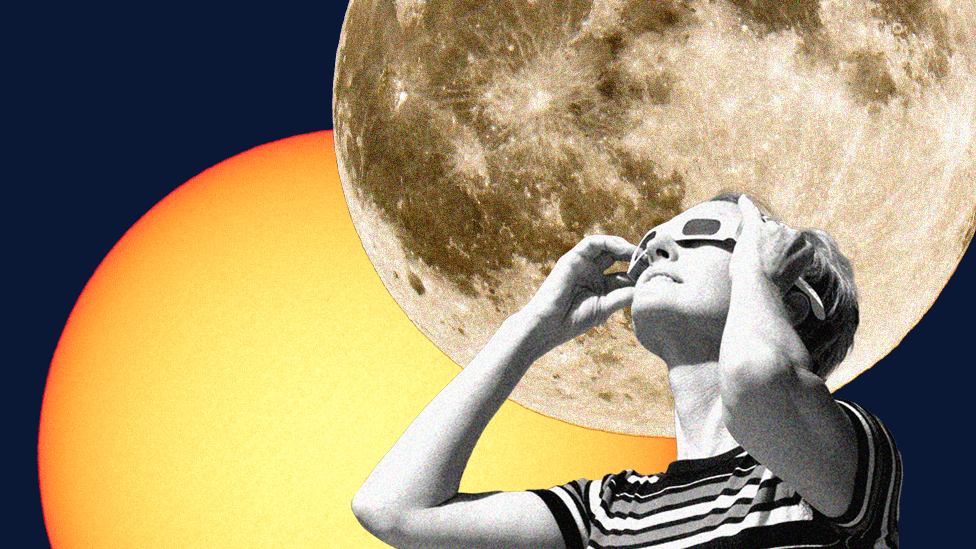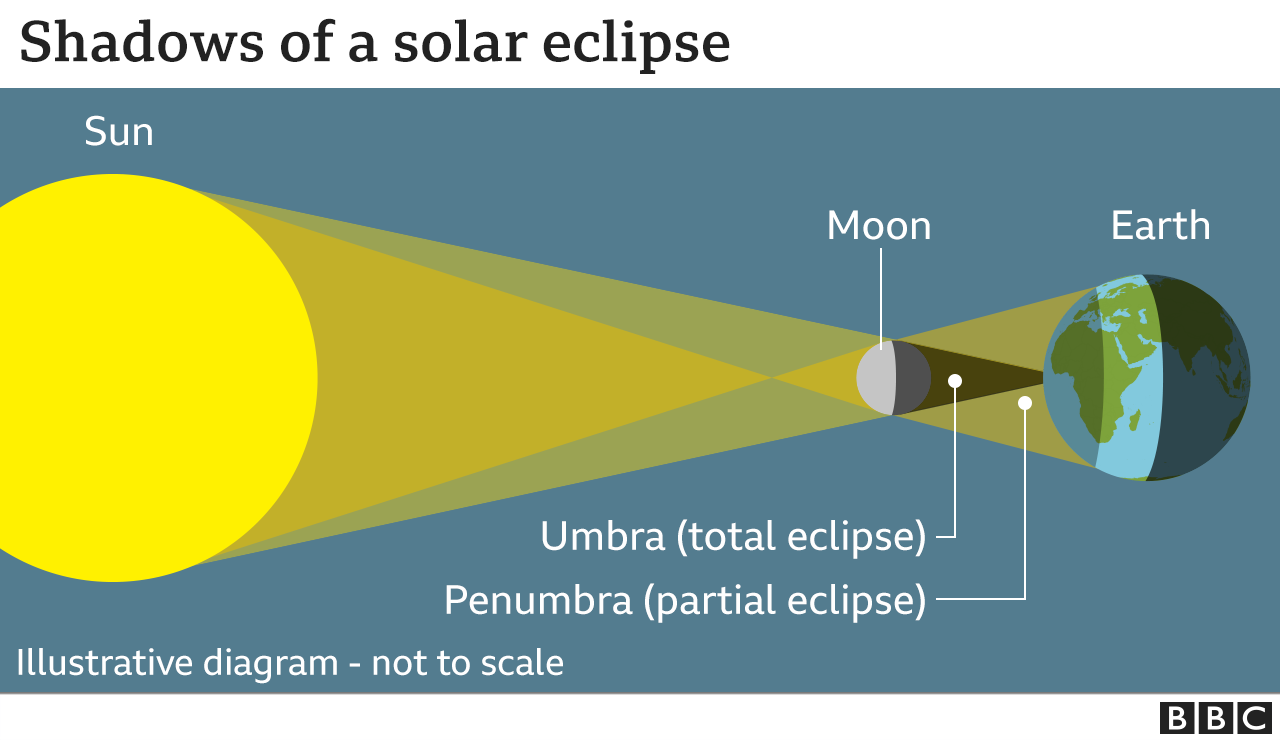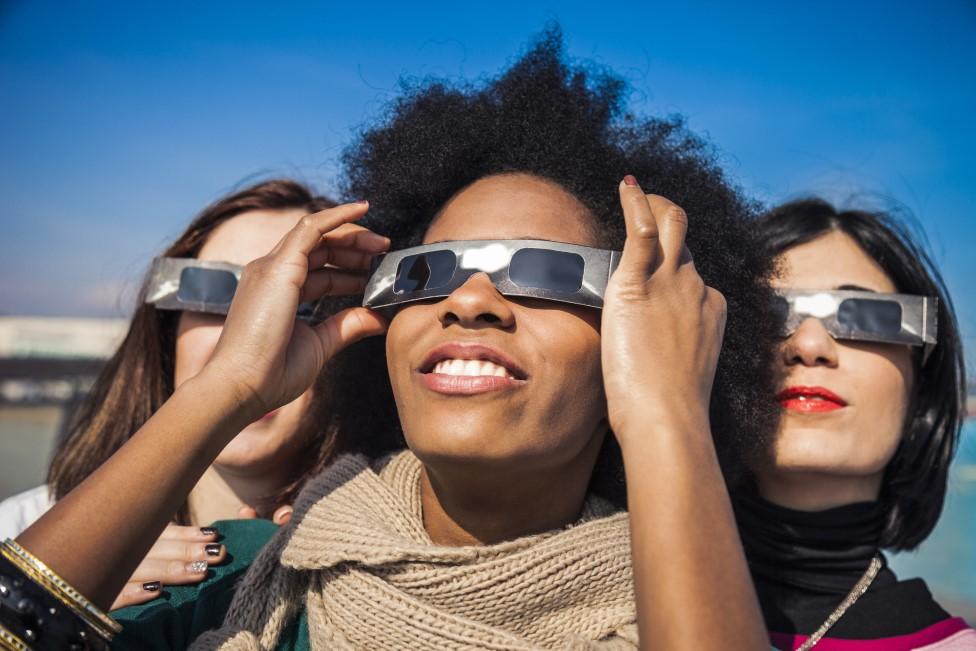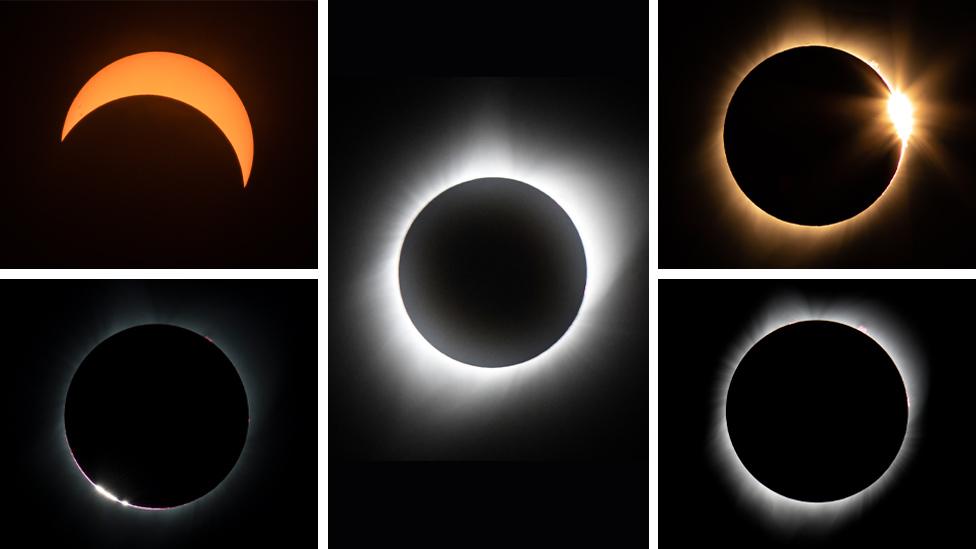2024 solar eclipse: What time is it and what will the weather be?
- Published

People across North America will be treated to the view of a lifetime later on Monday when a total solar eclipse spans across the continent, from Mexico to the very eastern tip of Canada.
Hundreds of events are already being planned for eclipse watchers to step outside, look into the sky and catch this rare, astronomical phenomenon.
If you want to be part of the fun, below is our comprehensive guide to where and how to see the eclipse.

What is a solar eclipse?
A solar eclipse occurs when the Moon moves between the Earth or the Sun, blocking some or all of the Sun's rays from reaching the Earth.
The phenomenon is a cosmic event, requiring the Sun, the Moon and the Earth to be in just the right alignment for the Moon to cast a shadow on our planet.
When this happens, the Moon casts two types of shadows.

One results in a partial solar eclipse, which covers only part of the Sun.
The other - and arguably the most spectacular - is called a total solar eclipse where the Sun is entirely covered by the Moon, save for a visible ring of light in the sky.

How rare is a total solar eclipse?
Solar eclipses themselves are not that rare - in fact, there are about two to four that occur per year.
But the likelihood of seeing a total solar eclipse is much rarer. The Earth is quite big, and most of it is covered by oceans. More often than not, humans don't get to see it in person.
In fact, this is the first solar eclipse this century to be visible in all three North American countries - the US, Canada and Mexico - making this upcoming one likely the only one that most of us will get to see in our lifetimes.

What time is it?
The timing of the eclipse will depend on where you are located.
The path of totality - meaning where the total solar eclipse will be fully visible - starts at around 11:07 local time in Mazatlán, Mexico, on the Pacific coast.
All in all, the phenomenon itself will last two hours. For those in the Eastern time zone, the path of totality will enter continental North America shortly after 14:00 EDT (19:00 BST), and exit at 15:46.
It will then move northeast, over Texas, the southern parts of Oklahoma, Missouri and Illinois, before making its way to Ohio and along the US-Canada border. The path will end in the Canadian Atlantic province of Newfoundland.

Here is a breakdown of when the total solar eclipse will occur in US and Canadian cities, all in local time:
San Antonio, Texas: 13:33 Central (19:33 BST)
Dallas, Texas: 13:40 Central
Carbondale, Illinois: 13:59 Central
Cleveland, Ohio: 15:13 Eastern
Buffalo, New York: 15:18 Eastern
Burlington, Vermont: 15:26 Eastern
Montreal, Quebec: 15:27 Eastern
Fredricton, New Brunswick: 16:33 Atlantic
Gander, Newfoundland and Labrador: 17:12 Newfoundland time

How long will the total solar eclipse last?
The answer to this question, too, depends on where you are.
According to Nasa, the total solar eclipse will span anywhere from one minute to four and a half minutes.
For people in the US, it will be longest at Radar Base, Texas, right on the US-Mexico border, where it will last a total of 4 minutes and 27 seconds.
Among Canadian cities, the total solar eclipse will be the longest in Sherbrooke, Quebec, where it will last 3 minutes and 26 seconds.

Where are the best places to see the eclipse?
Astronomers in the US and Canada have mapped out exactly where the path of totality will be. As long as you're on that path, you should be able to catch the total solar eclipse.
That path is 115 miles (183 km) wide, on average. Some big cities along it include Dallas, Indianapolis, Cleveland and Buffalo.
Niagara Falls will also be a great spot to catch the total solar eclipse, whether you're on the Canadian or American side.
For Canadians, the path of totality includes Hamilton, Montreal and Gander.
People close to the path will still be able to see the solar eclipse, albeit a partial one, and the percentage of the Sun covered by the Moon's shadow will depend on where you are.
Jan Cami, an astrophysicist at Western University in Canada and director of its Cronyn Observatory, noted that people should also account for the weather.
If it happens to be cloudy in your city, that can hinder your visibility of the solar eclipse even if you are in the path of totality.

What will the weather be like?
Some areas look much better than others, as the latest forecast is for heavy clouds over large parts of the path of totality.
In Texas and neighbouring states, there are warnings from the US National Weather Service (NWS) of severe weather including rain, hail and possible tornadoes.
Some of the cloudiest areas are those that will experience the eclipse first, including northern Mexico as well as Texas. San Antonio could be almost completely covered.
But the forecast improves further along the eclipse path, with southern Illinois and much of the Midwest expecting clear skies. Conditions should allow a "decent viewing" in parts of Arkansas, the NWS says.
Cloudy conditions may again obscure the view around the Great Lakes including Niagara Falls.
The best viewing conditions could be in New England. The sky cover looks "favourable" in Vermont and northern New York, according to the NWS office in Burlington.
Meanwhile, the Canadian weather service is forecasting largely clear skies over Quebec.
Partly cloudy conditions will not necessarily dampen the experience, particularly if the clouds are high and thin. No matter the weather, the sky will still dim considerably as the Moon's shadow travels across the Earth.

Where are gatherings taking place?
There are many gatherings planned across the continent for those who want to share the joy of seeing a total solar eclipse, from the Pacific coast of Mazatlán, Mexico, to a football stadium in Carbondale, Illinois, to the Atlantic shores of Bonavista, Newfoundland.
In the US, Nasa is hosting a series of events, including a viewing in Dallas at the Fair Park Cotton Bowl Stadium.

Some celebrations are spanning multiple days. In Cleveland, the Great Lakes Science Center is hosting a days-long festival that will culminate with a viewing.
These viewings are likely to be busy. On the Canadian side of Niagara Falls, officials have braced themselves for more than one million visitors - the city's biggest crowd ever.
On the US side, Terrapin Point, Prospect Point and the Niagara Falls Observation Tower have all been marked as "prime viewing areas" by National Geographic.
Folks there may also catch another rare sight if the weather co-operates - the sunny-day rainbow that hovers above the famous falls will become pink under the eclipse.
Are schools closing?
Monday is not a public holiday in the US or Canada, but many children will be off school all the same.
Some schools on the eclipse path will close or allow students to be absent - partly so they can enjoy the experience, and partly so authorities can navigate the traffic issues that are expected to arise from the influx of tourists hoping to get a glimpse of the once-in-a-lifetime event.
Other schools have planned special viewing events - with students' safety in mind.

Can it be viewed in the UK?
There will be no total eclipse viewable in the UK but there is the possibility of a partial eclipse being seen just before sunset in the western UK and in Ireland.
British cities with the best potential views include Cardiff, Edinburgh, Glasgow, Manchester, Liverpool and Leeds.
The partial eclipse will last from 19:52 BST to sunset. About 47% of the Sun is expected to be blocked by the Moon but to see it requires clear skies to the west.

Can I view the total eclipse online?
Readers outside North America who want to see the total eclipse can catch our live coverage of the event. There will be a livestream to watch the phenomenon as it happens.
You will be able to read live dispatches from our reporters who will be stationed at eclipse gatherings across the US and Canada.
What are the stages of eclipse?
By Science Editor Jonathan Amos

Possible stages - partial eclipse (top left), diamond ring (top right), Baily's Beads (bottom left), totality (bottom right) and a view of the corona (middle)
Partial eclipse: The Moon progressively covers the Sun's disc. Everything gets darker and darker.
Diamond ring: The last vestige of strong sunshine decreases to a brilliant point of light, as if a big diamond.
Baily's Beads: As the diamond dissipates, any remaining light sparkles through deep valleys on the Moon's edge.
Totality: Day turns to night, but be aware also of changes in temperature, in the wind, in the clouds and in birdsong.
Corona: Your chance to see the Sun's hidden secret - the delicate tendrils of light in our star's outer atmosphere, its corona.
And then it all happens in reverse. Totality is broken by the beads. The diamond reappears and expands the light back to its normal blinding intensity, and the corona is hidden once more.

How do you safely view the solar eclipse?
If you are planning on watching the total solar eclipse in person, it is recommended that you have the appropriate gear because looking directly at the Sun with the naked eye is dangerous and could result in permanent damage or blindness.
Experts recommend using solar eclipse glasses, which have a special filter that blocks damaging UV rays. These glasses are different from sunglasses, as they block all light entirely except that coming from the sun.
The American Astronomical Society has published a list of vendors who are selling solar eclipse glasses that will work.
If you already have a pair and want to test its authenticity, experts recommend wearing them inside. You should not be able to see anything except for very bright lights which would appear faint.
Here's how to safely watch the solar eclipse
If you can't get glasses, two pieces of paper and a pushpin might do the trick.
Simply pierce a hole using the pushpin in one piece of paper. With your back to the sun, hold that paper above your shoulder so the sun's rays can shine through that small little hole.
At the same time, hold up the other piece of paper in front of you. It will act like a screen, onto which the Sun's rays will be projected.

Can you take pictures of the solar eclipse on your phone?
You certainly can. However, eclipse photographers recommend a few hacks to make sure your pictures are as crisp as possible:
Use a sun filter on your phone's camera lens to protect it
A telephoto attachment clipped onto your lens could also help improve the photo quality
Switch off the flash before totality, for better pictures and to not spoil experience for others
Do not zoom in on the eclipse, as your photo might end up grainy
Use burst mode during totality, a feature that can help you capture that split second magical moment where the Sun is completely covered
If you want to film a video, use a tripod and make sure your phone is in wide-angle mode
Avoid looking at the Sun directly without eye protection.
If you're using a traditional camera, experts at the American Astronomical Society caution against looking at the Sun through an unfiltered camera lens while wearing your eclipse glasses, as the concentrated solar rays could damage the filter and enter your eyes, causing serious injury.

Is it worth it?
Whether you choose to snap a photo or savour the moment without your phone, the total solar eclipse promises to be an unforgettable experience.
"I've seen three total eclipses before and I have very vivid memories of each of them," Prof Cami said.
"People ask me, 'How is it as a scientist to watch the eclipse?' I mean, you forget that you're a scientist."
It is an "enormously awesome experience", he added, that you can not only see but feel around you.

More on the solar eclipse
IN PICS: Crowds gather in three countries
SCROLL: Follow every mile of the route
FANATICS: Eclipse chasers flock to N America
